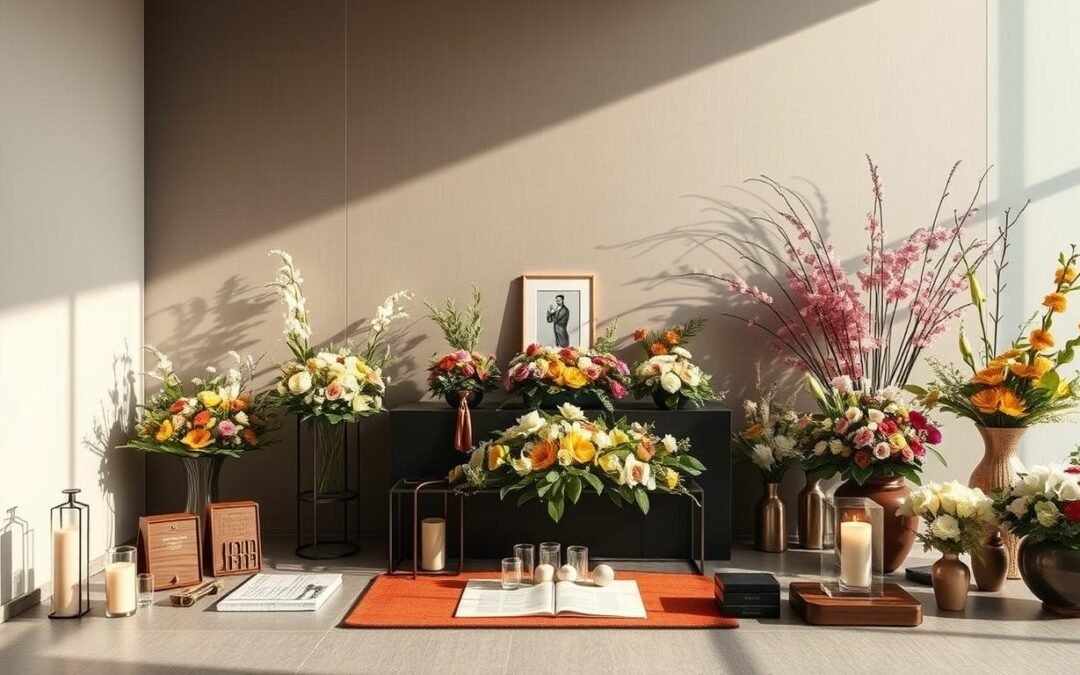In Singapore, Chinese funeral customs mix old traditions with new practices. These customs are key to honoring the deceased and keeping ties with ancestors. They show the importance of family and the belief that the dead can influence the living.
Funerals in Singapore usually last three to seven days, with three days being common. Family and friends gather to pay their respects. They often give money in white envelopes or use digital payments like PayNow or PayLah.
As Singapore’s Chinese community grows, their funeral customs stay strong. This shows how they smoothly move from old ways to new ones.
The mourning period is 49 days after the funeral. Every seven days, prayers are said, ending with a memorial service on the 100th day. The eldest son leads the rituals, showing respect for family order in Chinese culture.
This article aims to shed light on these rituals. It shows their deep meaning in the lives of those who experience them.
Understanding Chinese Funeral Traditions
Chinese funeral traditions show deep respect for ancestors and cultural ties. They are influenced by Confucianism, Buddhism, and Taoism. This creates a rich tapestry of cultural rituals with deep meaning. In Singapore, Chinese funerals honor the deceased and keep cultural heritage alive.
Funeral invitations for those aged 80 or older are pink, celebrating longevity. This shows the nuanced view of death in Chinese culture. Mourning attire is white, while red is avoided as it’s seen as happy and festive.
Occasionally, mourners wear pink for those who lived long lives. This adds respect and acknowledges their achievements.
During mourning, money offerings in white envelopes vary by relationship. These must be odd numbers, reflecting traditional beliefs. Families also burn joss paper, fake money, and small items. These are offered to the deceased for their journey in the afterlife.
Visiting gravesites annually during the Qing Ming Festival is key. It shows the importance of remembrance in these rituals. In Singapore, Chinese funerals last seven days. This allows family and friends to gather, mourn, and celebrate the life of the deceased.
Burial sites are chosen based on feng shui principles. This shows the spiritual care given to funerals. It reflects the community’s emotional connection to Chinese funerals in Singapore.
Significance of Funerals in Chinese Culture
The importance of funerals in Chinese culture is huge. It’s all about ancestral respect and showing love for family. These ceremonies honor the dead and keep family bonds strong. They believe that family ties never break, even after someone passes away.
In Singapore, funerals last three days. This time lets everyone come together. They share stories and celebrate the life of the person who has gone.
Money given to the family, called baijin or bojin, is very important. It helps pay for the funeral. It shows that the community is there to support the family in their sorrow.
Most people in Singapore choose cremation because of space issues. This change shows how society views death differently today. Yet, they keep the significance of funerals alive with special rituals. After cremation, families honor their loved ones with food and incense at ancestral altars.
These traditions show deep respect for the deceased. They also strengthen family ties and keep cultural values alive in a changing world.
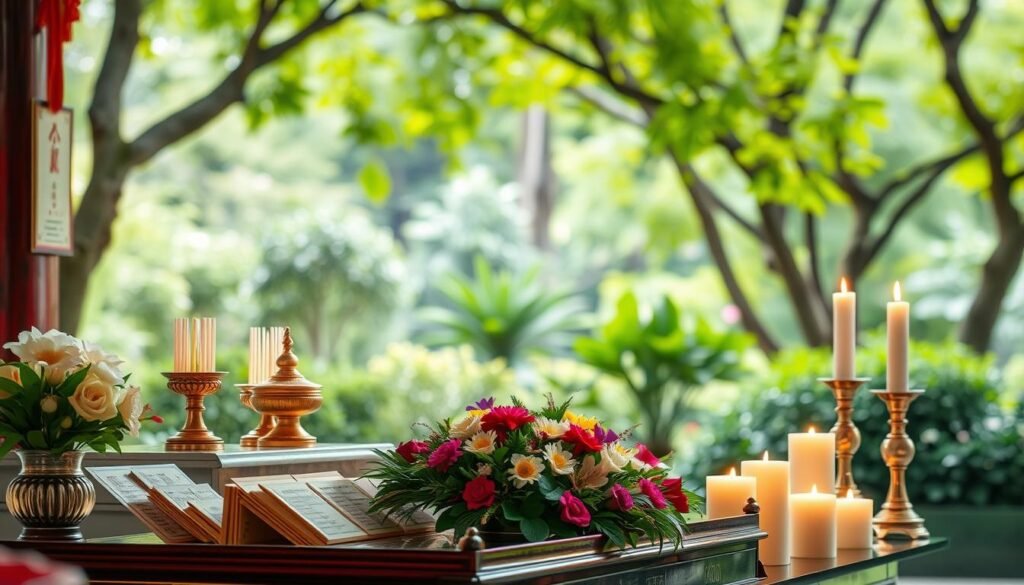
| Aspect | Description |
|---|---|
| Duration | Typically three days, with variations for prominent figures. |
| Location | Funeral parlours, family homes, or void decks of HDB flats. |
| Contributions | Baijin or bojin offered to aid funeral expenses. |
| Cremation Rate | Majority are cremated due to spatial limitations. |
| Ancestor Veneration | Offerings made at ancestral altars following cremation. |
Preparation for the Wake
The preparation for the wake is key in Chinese funeral customs. It involves several important steps to make the living space ready for mourners. This shows respect and understanding of spiritual harmony.
Clearing the Living Space
Clearing the living space is the first step. Families remove furniture and items to make room. This act symbolizes restoring balance and removing reminders of the deceased’s absence.
Covering Idols and Mirrors
Covering idols and mirrors with red cloth is another important practice. In Chinese culture, mirrors are seen as portals to other realms. Covering them shows respect for the spiritual realm and avoids offending spirits during this time.
Indicating a Death in the Household
To let visitors know, a red or white banner is displayed at the home’s entrance. This banner clearly shows there has been a death. It helps guests understand the situation and join in the grieving process. These markers are essential for showing support and remembrance.
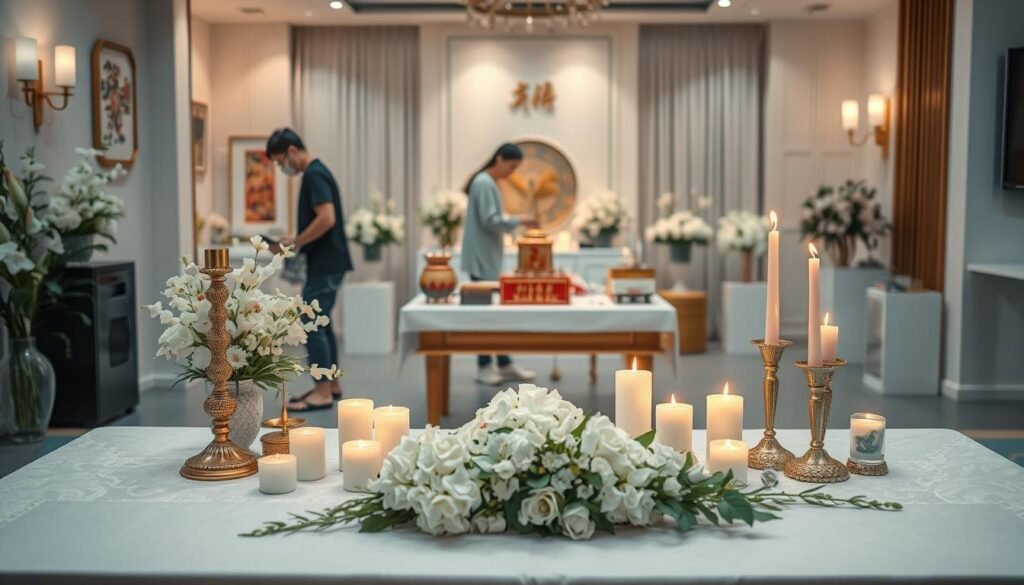
Mourning Attire and Customs
Mourning attire is key in Chinese funeral customs, showing deep emotions during loss. Traditionally, family members wore specific mourning clothes to show their bond to the deceased. This shows the respect and reverence in these rituals.
Traditional Mourning Garments
In the past, hemp clothing was used to show family sorrow. For example, in 1989, direct descendants wore these clothes for their grandfather’s funeral. Hemp clothing is traditional but less common now.
Now, mourning customs often use simpler clothes. Children and daughters-in-law wear black, while grandchildren wear blue. Great-grandchildren wear light blue.
Modern Adaptations of Mourning Clothes
The grandmother’s funeral in 2013 showed a shift to modern clothes. Family members wore white t-shirts with black trousers. This change shows Chinese funeral customs evolving.
Now, people focus on practical, less somber clothes. Yet, they keep the values of filial piety. Mourning pins are worn for 49 or 100 days, showing the mourner’s bond to the deceased.
Importance of Mourning Pins
Mourning pins, or Xiao, are vital symbols of family bonds during mourning. They are worn openly, showing respect for mourning customs and filial piety. Their colors show the mourner’s relationship to the deceased, blending tradition with modern expression.
Preparation of the Body
Preparing the deceased’s body is very important in Chinese funeral customs. It’s believed to affect the family’s future. Specific rituals are followed to honor the departed.
The eldest son traditionally washes the body. This is done with scented water to show respect. After washing, the body is dressed in ceremonial clothes. These clothes represent the family’s generations.
Ritual Washing of the Deceased
The washing of the deceased is done with great care. Family members help to show respect. A damp towel and talcum powder are used to clean the skin gently.
This ritual helps the family say goodbye. It strengthens the bond between the living and the deceased.
Traditional and Modern Dressing Practices
After washing, the body is dressed. Traditionally, the deceased wears many layers of ceremonial clothes. This honors their life and heritage.
In modern times, like in Singapore, families choose the deceased’s favorite clothes. They also place symbols like coins or rice with the body. This ensures a safe journey through the afterlife, blending tradition and modernity.
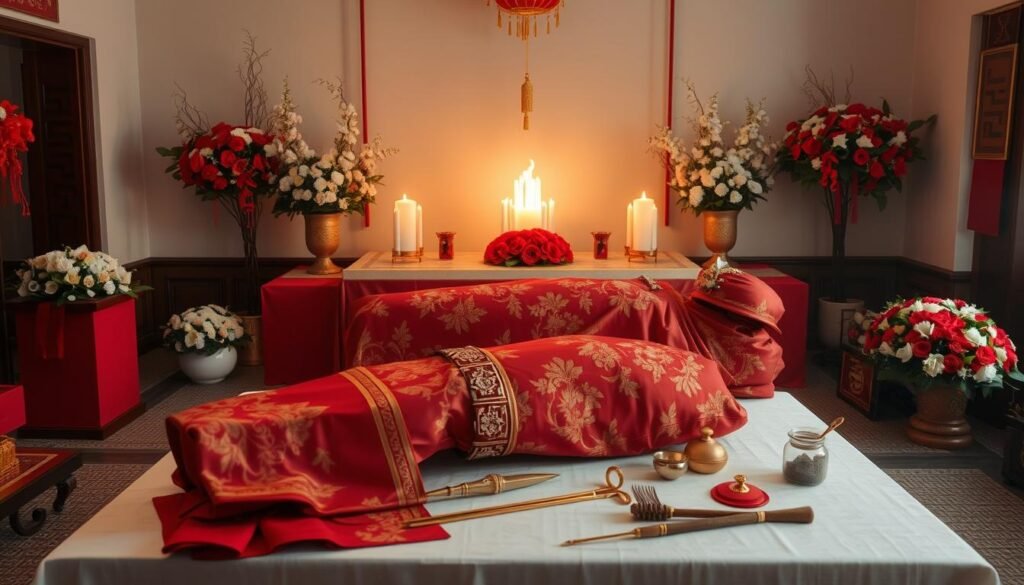
Modern Chinese Funeral Customs in Singapore
In Singapore, funeral customs mix old traditions with new ideas. This creates a rich mix of rituals that show how society is changing. A two-year study by SUSS faculty members Dr. Lye Kit Ying and Dr. Janice Kam looked into these changes. They talked to religious leaders, funeral directors, and regular people to understand these customs better.
Today, cremation is a common choice in Singapore, mainly because of space issues. Graves are often dug up after 15 years. Modern funerals include things like urns for ashes and special places in columbariums. Some families also choose eco-friendly options like sea burials, combining tradition with practicality.
The mourning period has also evolved, lasting either 49 or 100 days. This allows families to adjust to their needs. Different Buddhist traditions add to the richness of Singapore’s funeral practices, showing a balance between old and new.
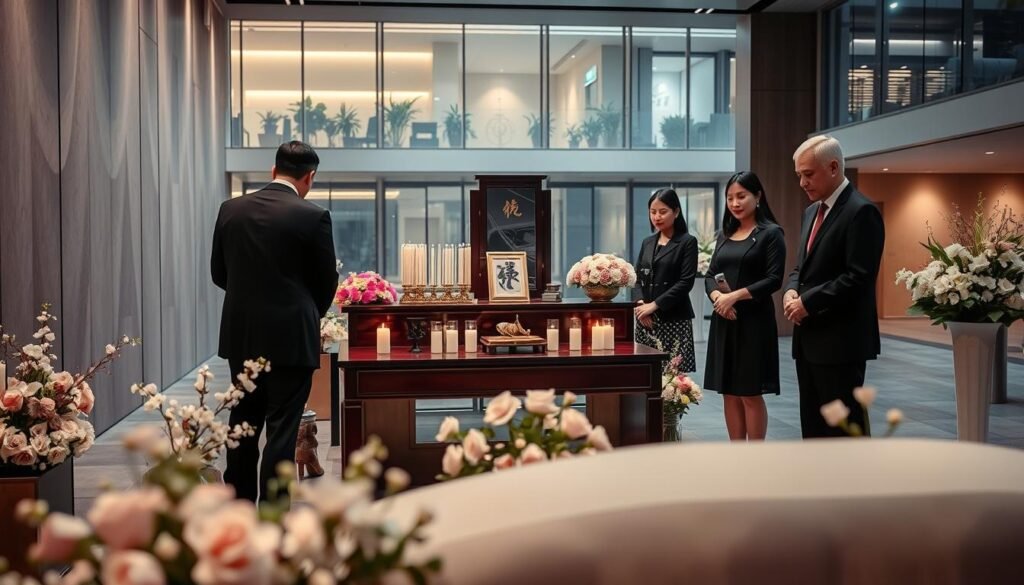
Community support is important in these ceremonies. Family and friends coming together shows respect for the deceased. Keeping noise levels down during funerals shows respect for the community, blending tradition with modern values.
| Aspect | Traditional Practices | Modern Adaptations |
|---|---|---|
| Burial vs. Cremation | Traditionally preferred burial | Cremation due to space limitations |
| Mourning Period | Fixed periods based on customs | Flexible mourning durations (49 or 100 days) |
| Funeral Offerings | Traditional paper offerings | Cremation ash urns, eco-friendly items, sea burials |
| Key Rituals | Buddhist rituals | Influence from multiple Buddhist schools |
| Community Involvement | Family-focused | Broader community participation encouraged |
The Wake: An Important Ritual
The wake is a key part of Chinese funeral customs, filled with tradition and deep feelings. It usually lasts from three to seven days. This time lets family and friends come together to remember and support each other.
Wake rituals help create a caring space where everyone can mourn together. It’s a time to share feelings and support one another.
Duration and Significance
The wake’s length can vary, sometimes lasting several days. It’s not just about saying goodbye. It’s also about showing filial piety, which is important in Confucian teachings.
This respect strengthens family bonds and honors the person who has passed away.
Vigils and Family Activities
During the wake, vigil customs are very important. Family members often stay with the deceased, doing activities to lift spirits. They might play games or share stories.
These activities help keep the community close and show the value of being together during hard times.
Customary Offerings at the Wake
Funeral offerings are a big part of the wake. Families prepare many things, like:
- Incense and joss paper, burned to comfort the departed
- Food offerings to feed the spirit
- Monetary donations from visitors to help with funeral costs
These offerings show hope for the deceased’s peaceful afterlife. They keep the spirit connected to loved ones. The mix of old and new in these practices shows how Chinese funerals in Singapore are changing.
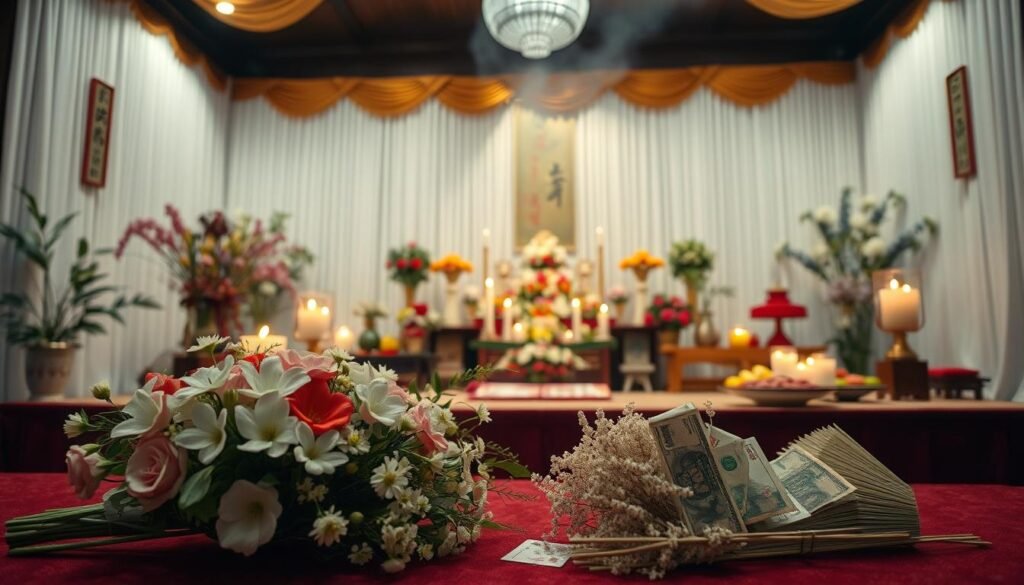
| Type of Offerings | Purpose |
|---|---|
| Incense | To purify the space and invite the spirit |
| Food | To honor the spirit and fulfill their needs |
| Joss Paper | To provide wealth in the afterlife |
| Monetary Donations | To assist with funeral expenses |
These elements during the wake show the deep beliefs about death and the afterlife in the Chinese community in Singapore. They show a commitment to tradition and family values.
Burial or Cremation Practices
In Singapore, people choose between burial and cremation based on cultural and spiritual beliefs. Traditional burials include a long funeral ceremony, lasting several days. This allows family members to pay their respects deeply.
The practice involves prayers for 49 days, symbolizing the spirit’s journey. The head of the family is key, attending the first ceremonies. This shows the importance of family bonds in these beliefs.
Traditional Beliefs Surrounding Burial
Burial customs in Chinese culture are deeply meaningful. They are often linked to Fengshui. Graves are placed on hillsides for better luck, according to belief.
During the funeral, family members throw earth into the grave. This represents their connection and final respect for the deceased.
Cremation as a Common Practice in Singapore
Cremation is popular in urban areas like Singapore due to space issues. Families choose cremation for its practicality. Ashes are placed in ornate urns and displayed at altars or columbaria.
This choice allows families to keep their connections with loved ones. They return to collect the bones and ashes, honoring the spirit at home. The shift from burial to cremation shows how funeral beliefs adapt to modern society.
Post-Funeral Rituals and Ancestor Veneration
In Chinese culture, post-funeral rituals are very important. They show respect for those who have passed away. Families do special rituals to keep in touch with their ancestors.
The Importance of Ancestral Altars
Ancestral altars are key in Chinese homes. They have pictures of ancestors, incense, and food. Families use these altars for daily rituals, showing their respect.
They believe their ancestors watch over and influence them. This belief strengthens their bond through these altars.
Rituals After Cremation
After cremation, families keep up their rituals. They offer food, incense, and joss sticks to honor their loved ones. The 49-day mourning period includes ceremonies to strengthen family bonds.
During this time, family members take part in rituals. They aim to deepen their connection with their ancestors. This shows their belief in staying connected even after death.
| Rituals | Description | Significance |
|---|---|---|
| Food Offerings | Providing favorite dishes of the deceased. | Strengthens ties with ancestors and symbolizes respect. |
| Incense Burning | Lighting incense at altars during rituals. | Represents prayers and communication with the deceased. |
| 49-Day Mourning Ceremonies | Series of events commemorating the deceased. | Enhances family unity and reinforces respect for ancestors. |
Conclusion
Modern Chinese funeral customs in Singapore mix old traditions with new ideas. These customs show deep respect and love for those who have passed away. Families try to keep their cultural values alive while moving forward in a changing world.
Actions like bowing, sending sympathy cards, and using flowers like white lilies show respect. People also come together to honor the deceased at burial sites or memorial services. This strengthens the bond within the community.
Singapore funerals are more than saying goodbye. They remind us of the strong ties that connect families and communities. Even as society changes, the values of respect, love, and remembrance will stay at the heart of these traditions.
FAQ
What are the main modern Chinese funeral customs in Singapore?
How important are funerals in Chinese culture?
What is involved in the preparation for a wake?
What types of clothing are worn during mourning?
How is the deceased’s body prepared for the funeral?
What activities take place during the wake?
What are the burial and cremation practices in Singapore?
How do families honor their ancestors after the funeral?
Source Links
- https://memorialfuneral.com.sg/blog/chinese-funeral-singapore/
- https://voffice.com.sg/understanding-chinese-funeral-traditions-in-singapore/
- https://www.thoughtco.com/chinese-funeral-traditions-687456
- https://www.mariecurie.org.uk/talkabout/articles/chinese-death-traditions/358268
- https://www.nlb.gov.sg/main/article-detail?cmsuuid=a3bfaffd-f823-4cf1-80a0-888db820bf1d
- https://en.wikipedia.org/wiki/Chinese_funeral_rituals
- https://nirvanamemorialsg.com/how-do-you-prepare-for-a-chinese-funeral/
- https://funeralservices.sg/all-about-funeral-wakes-in-singapore/
- https://www.dirtyelbows.com/how-to-plan-a-chinese-funeral/
- https://etspeaksfromhome.co.uk/2024/08/take-a-look-at-chinese-funeral-mourning-clothing.html
- http://en.chinaculture.org/gb/en_chinaway/2004-03/03/content_46092.htm
- https://www.suss.edu.sg/news-and-events/news/demystifying-singapore-chinese-funerary-practices
- https://www.singaporefuneralservices.sg/2023/03/30/chinese-funeral-services-customs/
- https://nirvanamemorialsg.com/funeral-chinese-tradition-honoring-ancestral-heritage/
- https://nirvanamemorialsg.com/what-are-the-chinese-grief-rituals/
- https://www.konfucijus.vu.lt/en/about-us/news/1099-ancestor-worship-and-funeral-customs-in-chinese-culture
- https://en.wikipedia.org/wiki/Ancestor_veneration_in_China
- https://memorialfuneral.com.sg/blog/navigating-the-funeral-process-in-singapore-a-comprehensive-guide/
- https://memorialfuneral.com.sg/blog/dos-and-donts-after-chinese-funeral/
- https://bpb-us-w2.wpmucdn.com/web.sas.upenn.edu/dist/b/160/files/2017/04/4c8b1af4d22f8c2b6be45c2d7d5b47e5-2-1dqwu6c.pdf

